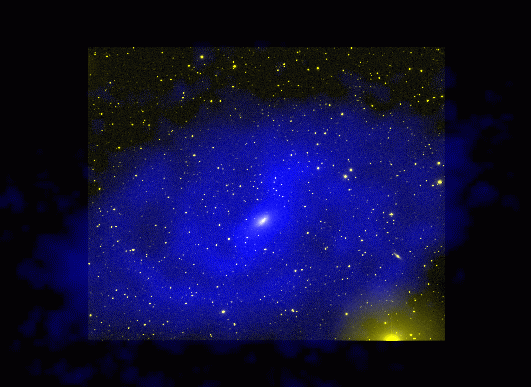
The accompanying picture shows NGC 2915, which Australian, Canadian,
and American astronomers have shown to be the darkest known disk
galaxy. While in the optically visible light of stars, (here
displayed in yellow) NGC 2915 appears to be a faint dwarf galaxy, in the
radio emission of neutral hydrogen gas (here displayed in blue)
NGC 2915 appears much larger, and has spiral arms. The team of
astronomers, lead by Gerhardt Meurer at Johns Hopkins University,
analyzed the rotation of the galaxy and showed that NGC 2915 is
composed mostly of "dark matter". Dark matter is extremely difficult
to detect since it does not emit any radiation. Its presence can only
be inferred from the gravitational influence of its mass. The ratio
of the total mass of the galaxy to the optically visible light is
nearly eighty (relative to the mass and light of the sun), the largest
such ratio found for a disk galaxy. NGC 2915 may be a galaxy that has
largely failed to form, except at its very center where the gravity of
the dark matter traps interstellar gas until enough builds up to form
stars. The results of Meurer's group will be published in the April
1996 issue of the "Astronomical Journal".
The optical portion of the picture was obtained with 3.9m
Anglo-Australian Telescope (AAT), while the radio image was obtained with
the Australia Telescope Compact Array (ATCA). Further details can be
obtained from:
| Gerhardt R. Meurer | office: Bloomberg Building, rm# 524 |
| Johns Hopkins University | URL: http://www.pha.jhu.edu/~meurer |
| Department of Physics and Astronomy | e-mail: meurer@pha.jhu.edu |
| Baltimore, MD, 21218, U.S.A. | phone: +1 (410) 516-5154 |
| U.S.A. | fax: +1 (410) 516-5096 |

